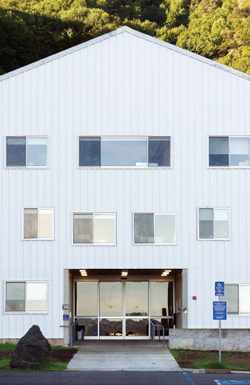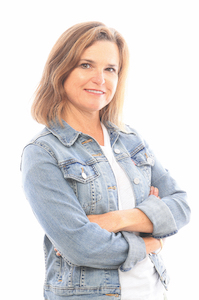Stepping onto the campus of the Romberg Tiburon Center, San Francisco State’s marine research facility on the eastern tip of the Tiburon peninsula, one might recall the final scene in the ’70s film Planet of the Apes when Charlton Heston stumbles on the artifacts of a once-thriving America. The vast two-acre parking lot seems to swallow the three cars parked near the main white building. Sitting on the pavement are a few dozen open fish tanks with tubes gurgling. But much of the rest of the property—the remains of an 18-foot concrete trestle, a rusted water tower, the exposed rusted pilings from a wharf built by the navy at the turn of the last century—hint that something big happened here a long time ago.
Actually, many things did. Low tide reveals 200-year-old bricks from a kiln possibly used by early early settlers, as well as tangled steel cables from when the Roebling’s Sons Company wound reels of cable in the 1930s and barged them out for construction of the Golden Gate Bridge. On dry land, empty barracks line one edge of the property, and an intriguing two-story brick blacksmith’s building hides in plain sight. Today the cavernous white main building, a 1942 structure the size of an airplane hangar, is used by a dozen or so San Francisco State scientists and students. As the university undertakes to renovate the campus to better serve users and the wider community, it’s also determined to celebrate the property’s multifaceted history and the occupants who came before.
The property first came into modern use as a cattle ranch, and then in 1877 it became a fish processing plant; the deep water just offshore allowed large vessels from as far north as Alaska to get close enough to offload their day’s catch of cod. In 1904, the federal government shelled out $80,000 to the Lynde and Hough company to build a coaling station. In 1931, the navy loaned part of the acreage to the state of California, which established the California Maritime Academy, the state’s first nautical training school. CMA was relocated to its present location in Vallejo during World War II when the Navy Net Depot was brought in to build huge steel anti-submarine nets—one seven-mile, 7,000-ton version of which was laid across the entrance of San Francisco Bay.
In 1958, the property was transferred to the Department of Commerce; in the 1960s it became the National Marine Fisheries Service’s (NMFS) Southwest Fisheries Center, which consolidated its operations to a portion of the acreage in 1973. In 1977, San Francisco State submitted a proposal to develop a field station and marine laboratory on 25 leased acres. The Romberg Tiburon Center for Environmental Studies, named for Paul F. Romberg, the university president who negotiated the lease, was born.
The Present
Today’s Romberg Tiburon Center is a 35-acre year-round research and teaching campus for studying the natural ecosystems of the bay and beyond. “Currently we have about 15 faculty members, 13 research technicians and 26 graduate students, plus educational and administrative staff working on various projects,” says RTC director Newell “Toby” Garfield, who has been with the center for 12 years. Many other organizations besides the university use the property, including the San Francisco Bay National Estuarine Research Reserve, the Smithsonian Institution Invasive Species Program, Taxon Biosciences, and two salmon restoration groups, the Tyee Club and Tiburon Salmon Institute.
 “Researchers and students actively investigate factors vital to the health of the bay and delta, which include the collapse of delta smelt and the nutrient ‘loading’ coming into the delta,” Garfield says. “For example, scientists estimate that the huge sediment input of the 1850s to the 1870s (from hydraulic gold and silver mining) has worked through the system, and this reduction in sediment supply and rising sea level will impact the wetlands and sea grass beds throughout the bay.”
“Researchers and students actively investigate factors vital to the health of the bay and delta, which include the collapse of delta smelt and the nutrient ‘loading’ coming into the delta,” Garfield says. “For example, scientists estimate that the huge sediment input of the 1850s to the 1870s (from hydraulic gold and silver mining) has worked through the system, and this reduction in sediment supply and rising sea level will impact the wetlands and sea grass beds throughout the bay.”
Meanwhile, other students are studying phytoplankton—its spontaneous blooms (some deadly for marine animals) as well as its potential as alternative fuel source. Still another RTC group is monitoring the long-term effects of the Cosco Busan oil spill on the bay’s sea grass beds. One timely project soon to hit your smart phone app store is a program tracking the micro-fluctuations in bay currents. Besides aiding Bay Area sailors and America’s Cup entrants seeking to steer themselves into a favorable drift, that information will provide valuable insight into future pollution spills up and down the coast. “There are over 60 monitoring systems from the Oregon border to San Diego, and we have four antennas in the bay that are measuring hourly variations of the surface currents,” Garfield says.
Beyond its own studies, RTC also offers the public a weekly seminar series and an informational open house in October. “This really is a special place,” Garfield reflects. “Besides having a half-mile of bayfront access and being the only marine institute on the San Francisco Bay (by contrast, Monterey Bay has seven; Chesapeake Bay has 12), the RTC serves the community in many ways. The focus on the bay and delta is directly related to the socioeconomic issues facing the state, and we are actively engaged in training the next generation of informed citizens, teachers and government employees.”
The Future
Last year RTC hired Flad Architects of San Francisco to develop a site plan for retooling its campus. Flad design director Stevens Williams’s own interest in American industrial heritage and commitment to the environment are right in line with RTC’s goals. Williams, a Mill Valley resident, designed the first LEED Platinum–certified campus in North America and is also working on sustainable building designs for the California Maritime Academy and the Monterey Bay Aquarium Research Institute.
“Places like RTC carry a sense of purpose,” he says, “a reminder of a time when our work was more basic: fishing, building a bridge, fighting a war. The rough-and-ready remaining structures (at RTC) are well suited to scientific fieldwork—moving large, wet and dirty objects. Our intent is to preserve as much as possible.”
Garfield agrees with that approach: “The buildings of historical value need to be renovated and repurposed, and we have to determine which buildings can be removed without losing historical context.” The real challenge, he adds, is cost. Carrying out the site plan will require an estimated $25 million—which won’t come from the state budget. Initial work would include infrastructure efforts like constructing a modern greenhouse for wetlands projects, rebuilding the wharf into a research facility, and a staged renovation of four other navy buildings for later conversion into first-rate research facilities.
Meanwhile, the same factors that have served RTC for research make it suited to a community purpose: emergency response. “When a large earthquake strikes the area,” Garfield says, “most planners assume that the road network will be significantly compromised. After the initial 72 hours, there will be a need to move supplies. The deep water adjacent to the rebuilt wharf would allow large supply ships to dock at the site and transfer material to smaller boats for distribution throughout Marin and Sonoma counties.” Likewise, the expansive flat terrain would allow supplies storage and helicopter landing space, and the site has sufficient backup power generators for sheltering a large number of people.
“I’m always amazed by how many people I talk to in Marin who have no idea that the center exists,” Williams says. “RTC researchers contribute so much to our knowledge of ocean systems and to the health of the San Francisco Bay estuary.” Even so, he wryly adds, “I can’t believe I never considered a fashion shoot as a way of boosting public awareness!”

Mimi Towle has been the editor of Marin Magazine for over a decade. She lived with her family in Sycamore Park and Strawberry and thoroughly enjoyed raising two daughters in the mayhem of Marin’s youth sports; soccer, swim, volleyball, ballet, hip hop, gymnastics and many many hours spent at Miwok Stables. Her community involvements include volunteering at her daughter’s schools, coaching soccer and volleyball (glorified snack mom), being on the board of both Richardson Bay Audubon Center. Currently residing on a floating home in Sausalito, she enjoys all water activity, including learning how to steer a 6-person canoe for the Tamalpais Outrigger Canoe Club. Born and raised in Hawaii, her fondness for the islands has on occasion made its way into the pages of the magazine.


